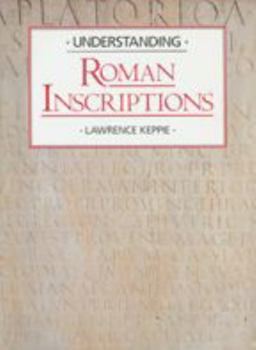Understanding Roman Inscriptions
Select Format
Select Condition 
Book Overview
In this classic study of the Late Roman Empire, one of this century's most eminent ancient historians surveys social, economic, and administrative developments from the end of the Principate and the accession of Diocletian to the collapse of the empire in the West.
Format:Paperback
Language:English
ISBN:0801843529
ISBN13:9780801843525
Release Date:December 1991
Publisher:Johns Hopkins University Press
Length:160 Pages
Weight:3.80 lbs.
Dimensions:0.6" x 7.4" x 9.7"
Customer Reviews
2 ratings
Understanding Roman Inscriptions
Published by Thriftbooks.com User , 15 years ago
The inscriptions left behind by the Romans and the assorted denizens of their Empire are one of the most powerful sources of information we have on them. Men of all classes - from senators to slaves - had their names inscribed on stones and buildings for a variety of purposes. Inscriptions served countless other purposes -from commemorating great military triumphs and the completion of building projects - all the way down to marking how many miles were left on a certain road or warning that the reader was treading on private property. They ranged from imperial propaganda to graffiti, and served purposes modernly met by things as diverse as billboards and newspapers. Lawrence Keppie's book, essential for a beginning to this topic and useful nonetheless for a seasoned student, is the best introduction and sourcebook on Roman inscriptions I have been able to locate. Keppie's book, well written and with line drawings and photographs throughout, examines every facet of Roman inscriptions - from how they were made all the way to how they are found, displayed, and documented by modern researchers. He looks at the roles they played in pretty much every aspect of life in the Roman Empire from the 1st Century BC to the 4th Century AD - road markers, tombstones, and records of imperial triumphs and the lives of important local citizens. For many towns and minor cities of the Empire, they are our best or only sources on the local history, culture, and celebrities and elite families. Especially useful are the several appendices which highlight the many, sometimes confusing abbreviations used on Roman inscriptions, and a list of all the Roman Emperors up to the 5th Century, including their full names as they typically appear on inscriptions. The bibliography is also thorough and contains a long list of highly useful books for those with a more professional-level interest in the subject matter. I very highly recommend this book for anyone interested in the Roman Empire!
How to make a dry subject interesting
Published by Thriftbooks.com User , 17 years ago
Latin as well as Greek epigraphy is a very rich but arid subject, and for the non-specialist the classic manuals and introductions are quite a nightmare to read - lists and lists of abbreviations, tons of technical details, and mostly no pictures of the real inscriptions to provide context and settings. This is due mostly to the fact that the most important guides about epigraphy are very old - Cagnat's "Cours d'épigraphie latine", the mandatory guide, is from 1914. So, historians and latinists who want to know more about epigraphy are usually deterred by this sort of bibliography, and lack the opportunity to use very interesting and rich sources. Studying epigraphy is much more than learning how to decypher the inscriptions - the real fun is to understand them in their context of production and use. This book is a fabulous introduction to the subject, both presenting the technical aspects of how to interpret the inscriptions and their social meaning, with a lively, solid but light text. The examples are presented in interesting and helpful ways, with lots of pictures - believe me, you can really have fun in decyphering the inscriptions form the Arch of Severus... But since this is an introductory book, it's by no means comprehensive. It still lacks a part about methodological implications and problems for interpreting data taken from inscriptions. But maybe this wasn't the author's purpose, anyway... So, for historians who'd like to understand more about the relationship between epigraphy and its uses for the study of Ancient History, I also recommend reading Epigraphic Evidence: Ancient History From Inscriptions, by John Bodel (ed.). Read both books and you'll have a brief but decent introduction to Latin epigraphy. Then you can go dive into Cagnat and the CIL.





